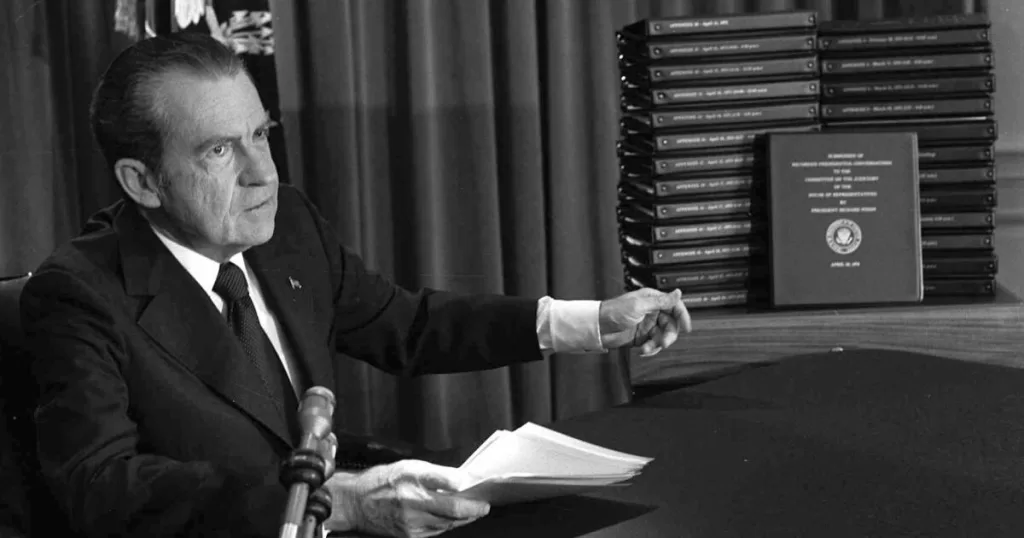Fifty years ago, Congress tried to rein in deficits and fix the budget process — or, perhaps, lawmakers were mostly just trying to wrest back some spending power from the White House.
If the goal was fiscal responsibility, the results have been mixed at best. But if the goal was only for Congress to flex its power over the budget, five decades of experience show: mission accomplished.
The Congressional Budget and Impoundment Control Act of 1974, signed by President Nixon while he was at risk of impeachment, established the House and Senate Budget Committees and the Congressional Budget Office to guide lawmakers in establishing and enforcing spending plans. It also created a process for Congress to create a budget each year and procedures to enact the spending and revenue measures that that budget envisioned.
If that sounds straightforward today, it wasn’t always so. Nixon had long fought with Congress over controlling spending, and he had been holding back money that Congress had authorized and appropriated.
In 1973 alone, Nixon withheld, or “impounded,” $18 billion in authorized and appropriated spending. This represented 34% of all domestic discretionary spending that year. If applied to the level of domestic spending today, that would be more than $240 billion in impoundments.
It would seem that reining in debt and deficits was not the main goal of the 1974 law. For lawmakers, the major appeal was the “Impoundment Control” part of the bill, intended to prevent the executive branch from subverting the legislature’s spending decisions.
With Congress not meaningfully restrained from irresponsible fiscal decisions, deficits and debt rose. Under President Reagan in 1981, policymakers focused more on the rising red ink and enacted budget measures that were designed to reach a balanced budget.
Congress set annual deficit targets, imposed pay-as-you-go procedures for tax cuts and entitlement increases so that any law with a price tag had to also have a plan to pay for it, established caps on annually appropriated spending, directed across-the-board spending cuts if those targets or caps were breached, and created other rules and processes to help balance the nation’s revenues and spending.
So, how well has Congress rebalanced power over the purse strings? And tamed deficits and debt? Not very well at all (except for four years starting in 1998 when the government ran budget surpluses — and when one of us led the House Budget Committee).
To control impoundments, the 1974 law established an orderly process by which the president could withhold funds either by temporarily deferring or by asking Congress for a rescission, which is a permanent reduction in spending.
From Ford through Trump, presidents requested a total of $91.9 billion in rescissions. Congress approved only $22.7 billion. Reagan sought half of all rescissions requested over the last 50 years, while Presidents George W. Bush and Obama requested none.
Congress itself initiated more than $380 billion in rescissions, but those came mostly at a time when Congress had imposed caps on annual appropriations. As a result, those rescissions did not reduce spending; they merely forced lawmakers to reallocate spending to remain under the caps.
The assessment here at the 50-year mark would have to be that although Congress rebalanced power in its direction, that did not generate significant savings for taxpayers.
As for the Congressional Budget Act part of the law, the 50-year history is more nuanced. Over the past 50 years, on 14 occasions Congress has failed to adopt an annual budget resolution, including this year. Failure occurred twice when Democrats controlled both chambers (2011, 2023) and four times when Republicans controlled both chambers (1999, 2005, 2007 and 2019). A modicum of bipartisanship is usually key to passage: With increasing polarization, for eight years beginning in 2003, a divided Congress could not enact a fiscal blueprint to inform spending and revenue decisions.
Two tax cuts have found broad support in recent years — the Tax Cuts and Jobs Act of 2017 and the Inflation Reduction Act of 2022 — but neither resulted in deficit reduction. That problem has only grown worse.
In 1974, federal revenue represented 17.8% of the economy. That fell slightly to 17.5% this year and averaged 17.3% over the entire period. Spending, however, was 18.2% of the economy in 1974 and tops 23.1% today.
Where has that spending increased? Not in funding our national security and not in the domestic discretionary accounts, all of which declined from 9.3% to 6.7% of GDP from 1974 to 2024. Spending for “mandatory” programs — particularly Social Security, Medicare and Medicaid — nearly doubled from 8.5% to 15.3% of GDP over the same period. This has contributed to debt growing from 32% of the economy in 1974 to more than 101% today.
Judged by these figures, the act has failed miserably. But should anyone be surprised? The nation’s budget each year is a product of politics, insatiable public demand for services and little public appetite to pay more taxes. No budget process that we’ve tried so far can force lawmakers to ignore those realities and achieve a certain fiscal outcome.
The nation’s fiscal forecast for the next 50 years is bleak unless presidents and Congresses today and in the future address the need to generate more revenue and slow the growth of mandatory spending. That will take a bigger and better bill than the Congressional Budget and Impoundment Control Act of 1974.
John R. Kasich, former chairman of the House Budget Committee, is a senior fellow at the Bipartisan Policy Center, where G. William Hoagland, former staff director of the Senate Budget Committee, is senior vice president.
